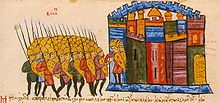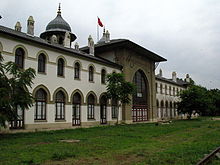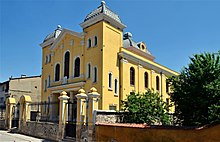Edirne
| Edirne | ||||
|
||||
 The Tunca Bridge with the Selimiye Mosque in the background |
||||
| Basic data | ||||
|---|---|---|---|---|
| Province (il) : | Edirne | |||
| Coordinates : | 41 ° 40 ' N , 26 ° 34' E | |||
| Residents : | 172,802 (2019) | |||
| Telephone code : | (+90) 284 | |||
| Postal code : | 22,000 | |||
| License plate : | 22nd | |||
| Structure and administration (as of 2019) | ||||
| Structure : | 24 malls | |||
| Mayor : | Recep Gürkan ( CHP ) | |||
| Website: | ||||
| Edirne County | ||||
| Residents : | 185,408 (2019) | |||
| Surface: | 844 km² | |||
| Population density : | 220 inhabitants per km² | |||
Edirne , formerly Adrianople ( Bulgarian Одрин Odrin , New Greek Αδριανούπολις Adrianoúpolis ), is the westernmost city in Turkey with over 150,000 inhabitants . It is located in the Bulgarian-Greek-Turkish triangle, in Eastern Thrace , the European part of Turkey. At the same time, it is also the center of the central district (Merkez). The former capital of the Ottoman Empire is now the administrative center of the province of the same name . In its history it was named Odrysai ( Thracian ), Orestia ( ancient Greek ) and Hadrianopolis ( Latin ).
In Edirne, the sultans of the Ottoman Empire made three peace agreements, in 1568 with the Holy Roman Empire and in 1713 and 1829 with the Russian Empire .
geography
location
Edirne is located about 220 km west of Istanbul near the border triangle Bulgaria , Greece and Turkey on the north bank of the Turkish-Bulgarian-Greek border river Meriç (Greek Evros, Bulgarian Mariza ). The tributary Tunca ( Tonzos in Greek , Tundscha in Bulgarian ) reaches Edirne from the north. The city has therefore hardly expanded to the west, but mainly to the southeast. The city is located in the fertile Thracian plain .
district
The central district ( Merkez ) Edirne borders in the northeast on the district Lalapaşa , in the east on the districts Süloğlu and Havsa and in the south on the district Uzunköprü . In the north the district has a border with Bulgaria and in the west with Greece .
In terms of area, it ranks third in the province, it is the most populous district and also has the highest population density . In addition to the district town, the district also consists of 37 villages ( Köy ) with an average of 348 inhabitants. Two villages have a population of a thousand or more: Tayakadın (1,568) and Kemal (1,000 inhabitants).
population
Population development
The following table shows the comparative population level at the end of the year for the province, the central district and the city of Edirne as well as the respective share at the higher administrative level. The figures are based on the address-based population register (ADNKS) introduced in 2007.
| year | province | district | city | ||
|---|---|---|---|---|---|
| real | % | real | % | real | |
| 2018 | 411,528 | 43.82 | 180.327 | 92.86 | 167,443 |
| 2017 | 406.855 | 43.97 | 178.910 | 93.06 | 166.494 |
| 2016 | 401.701 | 43.08 | 173.037 | 92.60 | 160.233 |
| 2015 | 402,537 | 42.58 | 171,386 | 92.40 | 158,369 |
| 2014 | 400.280 | 41.47 | 165.979 | 91.96 | 152.628 |
| 2013 | 398,582 | 41.16 | 164.048 | 91.60 | 150.260 |
| 2012 | 399,708 | 40.57 | 162.161 | 91.56 | 148.474 |
| 2011 | 399.316 | 39.80 | 158,929 | 90.94 | 144,531 |
| 2010 | 390,428 | 39.19 | 152.993 | 90.72 | 138,793 |
| 2009 | 395.463 | 39.49 | 156.155 | 90.66 | 141,570 |
| 2008 | 394,644 | 38.82 | 153.199 | 90.22 | 138,222 |
| 2007 | 396,462 | 38.02 | 150.717 | 90.28 | 136.070 |
climate
| Edirne (51 m) | ||||||||||||||||||||||||||||||||||||||||||||||||
|---|---|---|---|---|---|---|---|---|---|---|---|---|---|---|---|---|---|---|---|---|---|---|---|---|---|---|---|---|---|---|---|---|---|---|---|---|---|---|---|---|---|---|---|---|---|---|---|---|
| Climate diagram | ||||||||||||||||||||||||||||||||||||||||||||||||
| ||||||||||||||||||||||||||||||||||||||||||||||||
|
Average monthly temperatures and rainfall for Edirne (51 m)
|
||||||||||||||||||||||||||||||||||||||||||||||||||||||||||||||||||||||||||||||||||||||||||||||||||||||||||||||||||||||||||||||||||||||||||||||||||||||||||||||||||||||||||||||||||||
history
Names
Edirne is an old city. The first settlements are said to have existed as early as the 5th millennium BC. Have given. The city has had different names throughout its history. In its pre-Roman times it was known under the name Odrysia , probably based on the Thracian tribe of the Odrysen , or Uscudama, and belonged to Thrace . Odrysia was from the 5th to the 3rd century BC. Ch. The capital of the Odrysian Empire.
Antiquity

Between 171 BC BC and 168 BC The area was occupied by the Romans . During his reign Augustus renounced the conquest of Thrace and thus also of the city. Thrace was only conquered under Emperor Claudius . Hadrian ordered the city to be rebuilt and expanded around AD 125, giving it the name Hadrianopolis ( City of Hadrian ). In 378 the Romans were defeated there by the Goths under Emperor Valens ( Battle of Adrianople ).
In 395 the city became the center of the Roman province of Haemimontus . The city was the seat of the Archdiocese of Hadrianopolis in Haemimonto , which still lives on today as the titular diocese of the Roman Catholic Church .
middle Ages

Around 790-800 the city became the center of the newly created, Byzantine military-administrative district ( theme ) Macedonia . In the centuries that followed, rule over the city and the subject changed between the Bulgarian and Byzantine empires. In 813, the victorious Bulgarians under Khan Krum over the emperor Michael I. in the battle of Adrian Opel . Tsar Simeon I re- incorporated the province into the Bulgarian Empire in 914. In 927 after the 50-year peace treaty between Bulgarians and Byzantines, a large part of the topic came under Byzantine rule again.
In 1204 Adrianople was conquered by the Crusaders , but fell again into Bulgarian hands after the Battle of Adrianople in 1205. A final Byzantine period followed after 1250, and the Ottomans finally conquered the city in 1362. From 1368 to 1453 Edirne was the capital of the Ottoman Empire . In the middle of the 16th century the famous Ottoman court poet Hayâlî (1500? –1557) was Sandschakbey in Adrianople.
Late Ottoman period
In 1745 Edirne was hit by a great fire. A devastating earthquake followed in 1751 . As a result, the city lost its economic and political importance, but remained the center of a Vilâyet (Greater Province of the Ottoman Empire).
In the Russo-Turkish Wars of 1828–1829 and 1877–1878 Edirne was attacked and conquered several times. The Peace of Adrianople ended the first war in 1829. In the 1850s Edirne was one of the centers of the so-called Union Movement (Bulgarian Униатско движение) of the Bulgarian Catholics and in 1861 became the seat of the Bulgarian Catholic Church . According to the ethnography of the Vilayets d'Andrinople, de Monastir et de Salonique of 1878, Edirne had 16,220 households with about 58,000 male inhabitants in 1873. The Turks made up the largest proportion, followed by Greeks (approx. 16,000) and Bulgarians (approx. 10,000). Large Jewish and Armenian communities still lived in Edirne . The Bulgarian population was concentrated in the Barutluk mahallesi and Uzunkaldırım mahallesi districts east of the Selimiye Mosque in the old town. In the run-up to the Ilinden-Preobraschenie uprising (1903), a revolutionary committee of the BMARK was formed in the city in 1895 , which operated underground. Goze Deltschew built the organizational structure in the region between 1896 and 1900.
In the First Balkan War , the Bulgarians took the city after a four-month siege on March 26, 1913, although the defense was built by Western advisers and the city was considered impregnable. During the siege, planes were used for strategic bombing. In the Second Balkan War , the Turks were able to recapture Edirne, which was overcrowded with Bulgarian refugees from Eastern Thrace , and expelled or killed the Bulgarian population. When they were expelled, the Bulgarian educational institutions here, two boys 'grammar schools (including the "Dr. Petar Beron" grammar school ), one girls' grammar school and the four primary schools were closed. The Bulgarian churches were also closed and destroyed, with the exception of St. Constantine and Elena Church and Demetrios Church. A small part of the Bulgarian population returned after the war, but never reached their pre-war strength.
After the First World War , the city fell to Greece with the Treaty of Sèvres in 1920 , and with the Treaty of Lausanne it came back to Turkey.
Modern times
Since 2003 Hamdi Sedefçi (until March 2014) as Lord Mayor and Cemil Erdoğan (until 2008) and Namik Döleneken (2009-2011) as Mayor of the city. In 2006, a cultural partnership was established between the cities of Edirne and Lörrach in Germany , which was promoted to city friendship in 2011 and is also intensively maintained by Mayor Recep Gürkan (since March 2014). The aim is the exchange of students, pupils, interns, teachers and professors for the purpose of acquiring and developing mutual linguistic and cultural competence.
Economy and Infrastructure
General
Edirne mainly serves as a trading center for agricultural products, mainly grapes. The city's main products are textiles and textile raw materials, leather goods and carpets, as well as rose water and oil .
traffic
Street
Edirne is accessible via the toll road E 80 (also Trans European Motorway ), which leads from the Bulgarian-Turkish border crossing Kapitan Andreewo-Kapıkule near Swilengrad / Kapıkule via Istanbul and the bridge of the Martyrs of July 15th to Ankara .
rail
The İstanbul Sirkeci – Swilengrad – Sofia railway , which was built by the Compagnie des Chemins de fer Orientaux in the 19th century, also runs through the city . After the corrections to the border between Greece and Turkey by the Treaty of Lausanne in 1923, the two sections to the west and south of Edirne of the line belonging to the Chemin de fer Franco-Hellenique from 1929 onwards ran on Greek territory, only the few kilometers long section with the Edirne railway station was on Turkish territory. Trains from Edirne to Istanbul therefore had to pass through Greek territory. Drug smugglers used this route from the late 1960s to illegally enter Greece (so-called Midnight Express ).
After the tensions with Greece in the course of the Cyprus crisis , the Turkish State Railways (TCDD) built a new line from Pehlivanköy via Edirne to the Bulgarian border station Svilengrad , which went into operation in 1971 and only runs on Turkish territory. The old line was abandoned because the Greek railways had also built a new line exclusively on Greek territory. The old Ottoman train station has been restored and is now used as the rectorate and administration building of the Trakya Üniversitesi , the University of Edirne. Edirne received a new train station, which also has a loading point for motorail trains . There, ÖBB car trains from and to Vienna and the Optima Tours agency to and from Villach and Niš ( Serbia ) are handled.
Educational institutions
With the Thrace University (Trakya Üniversitesi) , Edirne has also been a university town with more than 30,000 students since 1982. There is a university hospital. International cooperations exist u. a. on the basis of the EU's Erasmus program with the Baden-Württemberg Cooperative State University Lörrach , the Goethe Institute (2008–2011), the Robert Bosch Foundation (2008–2011) and the Aachen Language Academy in Germany .
Attractions
The oldest buildings are the ruins of the Roman city walls with a Byzantine tower, the Macedonian Tower ( Turkish Makedon Kulesi ).
The Selimiye Mosque , a UNESCO World Heritage Site , built in 1575 by the architect Sinan , and the Rüstem Pasha Caravanserai (1554) are the most famous structures. Other mosques worth seeing are the Eski Cami (Old Mosque; 1414), Üç Şerefeli Cami (mosque with three balconies [on the highest minaret]; 1447) and the building complex of Sultan Beyazıd II , Sultan , located in the northwest outside the center and completed in 1488 Bayezit II Külliyesi , which contained a medical school, a hospital (Darüşşifa) , guest houses (Tabhane) , a Turkish bath ( Hamam ) , administration building and a primary school around a central mosque .
This complex is now home to the Turkish Museum for the History of Psychiatry, which was awarded the Council of Europe Museum Prize in 2004 . The Muradiye Mosque has typical Ottoman tiles and ornaments from 1426.
Edirne has three historical bazaars, the Ali Pasha Bazaar (1569) and the Arasta Bazaar, both built by Sinan, and the oldest, the Bedesten Bazaar (1418). Today the dealers hardly serve the supply of everyday objects or food; many stalls offer flavored soaps in the form of fruits and vegetables. It is considered a popular souvenir.
The ruins of the old sultan's palace in Edirne house a well-preserved Ottoman tower ( Adalet Kasrı ) and a hunting lodge. The beautiful and renovated bridges of Edirne were built in Ottoman times over the Tunca and the Meriç. Also worth seeing are the typical old Ottoman wooden houses in the old town of Kaleiçi .
Of the Bulgarian Orthodox churches, only the Church of St. George (1880) and the Church of St. Constantine and Helena (1869) remain, which have been restored in recent years. The Edirne Great Synagogue was rebuilt until 1907 after a fire in 1905 that destroyed all 13 synagogues in the city. After the synagogue was no longer used in 1983, the building fell into disrepair. From 2010 it was restored and reopened in 2015.
In Edirne there is also an archaeological and an ethnographic museum with finds from Thrace as well as a museum for Turkish and Islamic art. A memorial to the memory of the Treaty of Lausanne is now housed in an architecturally charming old train station on the disused line . In front of the building is a several meters high steel memorial in the style of classical modernism, reminding of the War of Independence and the Treaty of Lausanne as the "birth certificate of the republic".
kitchen
A culinary specialty of the city is the Edirne ciğeri . The dish consists of thinly sliced beef liver that is breaded and deep-fried and then served with raw onion and deep-fried red peppers . Many small snacks in the city offer this dish and mostly also the kofta , which is common in all of Southeastern European cuisine .
Oil wrestling match
Edirne is the center of the ancient Turkish national sport of oil wrestling (Kırkpınar). The venue for the most important tournament in the whole country is an arena on the outskirts.
Personalities
- Agathangelus of Constantinople (1769–1832), Orthodox Patriarch of Constantinople
- Athanasios I (1230-1310), saint and patriarch of Constantinople
- Cem Adrian (* 1980), singer and songwriter
- Esmahan Aykol (* 1970), journalist and crime writer
- Hagop Baronian (1843–1891), writer, satirist, educator, journalist and social scientist
- Rupen Binemeciyan (1857–1912), Armenian actor
- Nikola Dolaptschiew (1869–1948), Bulgarian freedom fighter
- Enver Duran (* 1945), physician and rector of the Thrace University (2004–2012)
- Joseph Halévy (1827–1917), French orientalist and Africa traveler
- Joseph Herbst (1875–1925), Bulgarian journalist
- Abdurrahman Hibri (1604–1658 or 1659), Ottoman poet and historiographer
- Sabiha Kasimati (1912–1951), Albanian ichthyologist
- Mehmed II (1432–1481), Ottoman Sultan
- Perchouhi Partizpanjan-Barseghjan (1886–1940), Armenian writer
- Manfred G. Raupp (* 1941), German agricultural scientist and economist, honorary citizen of the city of Edirne
- Revani (1475–1524), Ottoman poet
- Mehmed Şükrü Pascha (1856–1916), "Hero of Adrianople" (Edirne Müdafii) , brigadier general of the Turkish army, who surrendered Adrianople to the Bulgarians in March 1913 after a five-month siege in the 1st Balkan War
- Erhan Tabakoğlu (* 1967), doctor and rector of the Thrace University (since July 2016)
- Victor Tafel (1881–1946), German metallurgist
- Nikodim Tiweriopolski (1864–1932), Bulgarian clergyman
- Georgi Walkowitsch (1833-1892), Bulgarian politician and diplomat
- Yener Yörük (* 1963), doctor and rector of the Thrace University (August 2012 to June 2016)
- Nikolaos "Nikos" Zachariadis (1903–1973), Greek communist and head of the counter-government in the civil war
literature
- Edirne in the 17th century after Evliyā Çelebī. A contribution to the knowledge of the Ottoman city. Schwarz, Freiburg 1975 (dissertation, University of Munich, 1972) ( digitized version ).
- Fokke Theodoor Dijkema: The Ottoman historical monumental inscriptions in Edirne. Brill, Leiden 1977, ISBN 90-04-05062-0 .
- Erol Haker: Edirne, its Jewish community, and Alliance schools 1867-1937. Isis Press, Istanbul 2006, ISBN 975-428-315-X .
Web links
Individual evidence
- ↑ a b Türkiye Nüfusu İl ilçe Mahalle Köy Nüfusları , accessed on April 13, 2020
- ↑ Central Dissemination System / Merkezi Dağıtım Sistemi (MEDAS) of the TÜIK , accessed on June 10, 2019
- ^ Recep Gürkan's inaugural visit to Lörrach with Hilmi Ibar , Jörg Lutz , Manfred Raupp
- ↑ Page no longer available , search in web archives: Nurettin Heybeli: Sultan Bayezit II Külliyesi. One of the Earliest Medical Schools - Founded in 1488. The Association of Bone and Joint Surgeons, December 2008 (PDF; 500 KiB)
- ^ Badische Zeitung: Manfred Raupp honorary citizen of Edirne






